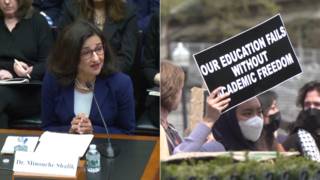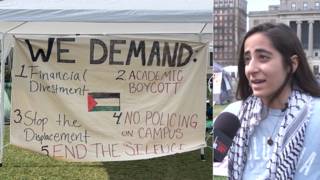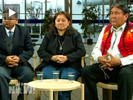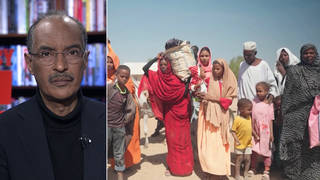
Related
Guests
- Bill HareCEO and managing director of Climate Analytics and the lead author for the Intergovernmental Panel on Climate Change’s 2007 reports, “Mitigation of Climate Change” and “The Synthesis Report.”
A shocking new report commissioned by the World Bank is warning temperatures could rise by 4 degrees Celsius (7.2 degrees Fahrenheit) by the end of the century, causing devastating food shortages, rising sea levels, cyclones and drought — even if countries meet their current pledges to reduce emissions. If these promises are not met, the increase could happen even sooner. Meanwhile, scientists say it is still not too late to minimize the devastating impact of climate change. A separate report by the Climate Action Tracker says global warming could be kept below 2 degrees. “This is an imminent risk that will affect every living person on the planet if we push the ecosystems of the world into a major extinction crisis,” says Bill Hare, a leading physicist and environmental scientist who helped produce both of these latest reports. Hare is CEO and managing director of Climate Analytics and the lead author for the Intergovernmental Panel on Climate Change’s 2007 reports, “Mitigation of Climate Change” and “The Synthesis Report.” Hare calls for a carbon tax — putting a small price on emissions — to reduce the benefit of burning fossil fuels and enable funding of new technologies to reduce the disastrous release of greenhouse gases. [includes rush transcript]
Transcript
AMY GOODMAN: As climate negotiators from nearly 200 countries are meeting here in Doha, the latest scientific research shows their current efforts may not be enough to avoid a catastrophic shift. A new report commissioned by the World Bank finds the world’s temperature could increase by 4 degrees Celsius over preindustrial levels by the end of the century, even if countries meet their current pledges to reduce emissions. If these promises are not met, the increase could happen even sooner. The potential impacts of a 4-degree rise include unprecedented heat waves, threats to food security, loss of ecosystems, and a life-threatening rise in sea levels. World Bank President Jim Yong Kim described the impact.
JIM YONG KIM: This report is a sobering look at what a 4-degree Celsius warmer world would look like. There would be massive disruption in some of our most basic systems—water supply, the viability of coastal cities, entire populations that live in low-lying areas. But moreover, it has implications for disaster risk management. It has implications for food supply. And most importantly for us, the worst impacts are going to happen in the poorest countries, to the poorest people.
AMY GOODMAN: But scientists say it’s still not too late to minimize the devastating impact of climate change. A new report by the Climate Action Tracker says global warming could be kept below 2 degrees Celsius, but only if urgent action is taken now.
For more, we’re joined by a leading scientist who helped produce both of these latest reports. Bill Hare is CEO and managing director of Climate Analytics. He was a lead author for the IPCC’s “Climate Change 2007: Mitigation of Climate Change” component of its Fourth Assessment Report. That is a fancy title for a report that came out in 2007 from the IPCC, which won the Nobel Peace Prize.
And we welcome you, scientist Dr. Bill Hare, to Democracy Now!
BILL HARE: Hello.
AMY GOODMAN: It’s great to have you with us. Talk about what you have found in this latest report.
BILL HARE: Well, in the World Bank report, we looked at the consequences of a warming of 4 degrees above the preindustrial climate. And the findings were really quite startling, even for those of us who work in the area of looking at climate impacts. We found—I guess one of the most striking findings was the risk of extreme heat waves in the future, heat waves like we’ve never seen occur across many regions of the world, often with the highest relative changes and most important changes occurring in the tropics, but also in countries like the United States and across Europe.
Another big impact that we see, which is relevant to the discussion now, is that there’s a very big risk of very intense tropical cyclones, tropical hurricanes in the future. Whilst we expect the overall frequency of tropical hurricanes to decrease, the most intense ones could become more common and stronger. And Hurricane Sandy and the typhoon in the Philippines now are an example of the kind of things that are going to get more dangerous and perhaps more common in the future, actually.
AMY GOODMAN: This is what a 4-degree world looks like, as you say?
BILL HARE: Mm-hmm, mm-hmm.
AMY GOODMAN: That’s 4 degrees Celsius.
BILL HARE: That’s right.
AMY GOODMAN: That’s what? That’s, in Fahrenheit, we’re talking about nearly—
BILL HARE: Seven degrees or so.
AMY GOODMAN: —eight degrees—
BILL HARE: Yeah, 8 degrees, that’s right.
AMY GOODMAN: —nearly 8 degrees Fahrenheit.
BILL HARE: Eight degrees Fahrenheit.
AMY GOODMAN: But explain even what—when we talk about the 2-degree Celsius sort cutoff now, that doesn’t mean 2 degrees of air temperature exactly. We’re talking about mainly water rising to that level. Explain what 2-degree rise means.
BILL HARE: Well, a 2-degree Celsius warming doesn’t sound like much, but actually it’s a very big change for the earth. And it’s going to have a very big impact on natural ecosystems and on already risky regions on crop production and agriculture. The latest science that we showed in the World Bank report indicates that there’s a very significant risk that we might even lose most of the world’s coral reefs—at under 2 degrees, actually.
AMY GOODMAN: The coral reefs.
BILL HARE: Most of the coral reef systems could go. We saw the risk of a sea-level rise of up to a meter by 2100, from a roughly 2-degree Celsius warming. Such changes are actually rather dramatic and will have very severe consequences for coastal communities, cities, livelihoods in many places. In Africa, for example, a 2-degree warming could produce very large damages to already poor countries, to their agriculture, and bring along with it many other health risks. So, of course, one can’t catalog the entire list, but for many of the most—of the most vulnerable countries in the world, they already see 2 degrees as an extremely dangerous level of warming.
AMY GOODMAN: So if the water rises by 2 degrees Celsius—
BILL HARE: By one meter.
AMY GOODMAN: —or almost 4 degrees Fahrenheit, by one meter, you’re saying, rises—
BILL HARE: One meter, roughly, yes.
AMY GOODMAN: —the air gets even hotter.
BILL HARE: The air would, for about a one-meter sea-level rise, goes along with about a 2- or 3-degree warming, actually. That’s what we estimate. And, of course, that’s just over 100 years. The seas would continue to rise for many centuries. So, holding warming at 2 degrees would actually lead to several meters of sea-level rise over a few hundred years, which would inundate many of the world’s major cities, actually.
AMY GOODMAN: So, what is causing this?
BILL HARE: Well, what’s causing it is the emission of greenhouse gases, particularly carbon dioxide from the burning of fossil fuel—coal, oil and gas. That’s the primary driver of human-induced climate change. And that’s actually the other report that we’ve been involved with recently, is the United Nations Environment Program Gap Report. And that shows clearly that actually we can take steps to reduce emissions quite quickly and cost-effectively and at large benefit. And that’s, in fact, one of the big discussions going on here in Doha, is can we actually rise to that challenge politically, because we know we have the economics would work, the technology is there, but the question is really one of political ambition to get countries and industries moving in the right direction.
AMY GOODMAN: Well, we’re from the most powerful country here, the United States—
BILL HARE: Yes, yes.
AMY GOODMAN: —at the Doha summit, very much determining what takes place.
BILL HARE: Yes.
AMY GOODMAN: Most of the discussion in the U.S. corporate media—
BILL HARE: Yes.
AMY GOODMAN: —is about the fiscal cliff.
BILL HARE: Yes.
AMY GOODMAN: It’s about what the U.S. budget can afford. Can you talk about the climate cliff?
BILL HARE: Well, we have a climate cliff, for sure. We’re facing a carbon tsunami, actually, where huge amounts of carbon are now being emitted at a faster rate than ever. And it’s that carbon tsunami that’s likely to overwhelm the planet with warming, sea-level rise and acidifying the oceans. That’s the bad news.
The good news is that actually there’s a lot of money to be made, a lot of new industries to be built, from actually taking the steps to introduce renewable energy, wind, solar power and so on, electric cars and hybrid cars. These are the technologies of the future, and these can generate jobs, help rebuild economic growth, at the same time as we get out of the carbon-intensive pathway of the past. And I think it’s a challenge for politicians, not just here in Doha, but in the United States, to realize that opportunity. And actually introducing something like a carbon tax in the United States would help dig the U.S. out of its fiscal cliff, actually, and produce substantial economic benefits in the long term.
AMY GOODMAN: What does a carbon tax mean? Your talking about a country where the dialogue in the media—
BILL HARE: Yeah.
AMY GOODMAN: —it’s still around whether climate change is human-induced.
BILL HARE: Yes.
AMY GOODMAN: It’s certainly not about how do we solve it.
BILL HARE: Sure. I mean, that’s a discussion you have to resolve in the U.S. But I do see that, after Sandy, anyway, that the mood has shifted in the American public. If you look at the opinion polls, that I read, anyway, the press reporting, then you see there’s a change in the mood. And there’s also a change, if I’m reading the press reports in the U.S. correctly, about discussing fairly radical ideas that—for example, in the Clinton administration once discussed of a modest carbon tax. And a carbon tax means putting a small price on the emission of carbon from power stations, cars and so on. And that would reduce the benefit, but it would enable the funding of new technologies to come in and reduce this disastrous emission of greenhouse gases that’s happening. So it would be a way, in fact, of the U.S. turning the curve not just on its financial problems—it would help there, wouldn’t solve them, but it’d help—but it would also start to introduce new technologies more rapidly into the U.S., which, with its history and capacities for innovation and entrepreneurial invention, I’m sure, could profit from this.
AMY GOODMAN: The head of a IPCC—
BILL HARE: Yes.
AMY GOODMAN: —the [Intergovernmental] Panel on Climate Change, Rajendra Pachauri, said in his address here that mass extinctions could accompany a 4-degree change—that’s 4 degrees Celsius, 7.2 degrees Fahrenheit—even more than with a 6-degree rise in temperature. Why is that?
BILL HARE: Yeah, I mean, look, climate science is replacing economics as a dismal science. It is producing stories like mass extinctions coming from warming caused by a variety of different phenomenon. If you have a mountain species living on a mountain, if the temperature rises too much, the species can’t move up high enough, and they disappear. If the oceans get too warm, it will kill species in the oceans. The same thing applies to forests. This is an imminent risk that will affect every living person on the planet if we push the ecosystems of the world into a major extinction crisis. It will cause massive problems for us as human societies. But that’s the dismal part of it. But we can really avoid that. And that was the point of the World Bank actually doing this 4-degree report, to say, look, this is the risk we see coming, but—and we need to have it visibly in front of us so we can take the steps to avoid it.
AMY GOODMAN: And just to clarify, I meant, you know, it could—4 degrees could lead to a mass extinction; 6 degrees, of course, even worse. Let me ask you about what Oxfam said, the international relief and development organization, recently launching a campaign calling on the World Bank to stop funding large land deals, arguing such deals increase food insecurity in parts of the world where hunger is already prevalent. Now, I particularly ask you this because the report you did was commissioned by the World Bank.
BILL HARE: Yes. Well, many of us in the policy community have disagreed with the World Bank’s investment in fossil fuels and historically other kinds of destructive activities. And I think this may be a signal that the bank intends to change direction. Of course, we don’t know. But the president certainly is—the new president is certainly committed to changing the direction of the bank and making climate front and center of what the bank’s doing. So let’s hope it does presage a big change in the bank’s activities towards more climate-friendly activities. And if it doesn’t, then it will be another lost opportunity. I’m personally optimistic, though, with his commitment to change, that the bank will move forward with this. And if it does so, it will send a very powerful community signal to the development community worldwide: The time has come; we must change direction, or else we face catastrophic risks in many vulnerable regions.
And, of course, poor countries aren’t the only places at risk. Hurricane Sandy has shown, yet again, that even rich countries have regions that are extremely vulnerable to climate change. No matter what the good intentions have been in the past to build up measures to prevent storm risks and so on, ultimately these big storm events—and they will get worse under climate change—will overwhelm cities and societies.
AMY GOODMAN: What we saw in New York and New Jersey for Superstorm Sandy—
BILL HARE: Yes.
AMY GOODMAN: —the waters rising, talk more about it, for New York and New Jersey, for these places.
BILL HARE: Well, these places are relatively low-lying and at risk from storm surges. It’s been known for many years that even a small sea-level rise, combined with hurricanes and storm surges, could lead to very large infrastructure costs. In fact, Hurricane Sandy nearly derailed the World Bank report, because one of its other authors was actually in Brooklyn, living there, was cut off from power and internet for days. We got through that. But we felt that firsthand, really, you know, of what was going on in New York. These problems are replicated in very many large cities around the world, with populations much larger and more vulnerable than New York.
AMY GOODMAN: Let me ask you about U.N. climate negotiator Todd Stern, not him personally—
BILL HARE: Yes.
AMY GOODMAN: —but the U.S.'s stance, seems very much—and there are a lot of critics who are saying that the U.S. is pushing for a new paradigm of voluntary pledges to cut emissions. What's wrong with voluntary pledges?
BILL HARE: It’s just not enough. I mean, the whole problem we have with climate change is known as the collective action problem, which means we all need to agree to go in the same direction so every actor has the confidence that the additional funds they’re spending are going to be matched by someone else. If we don’t have a collective agreement, then there won’t be any incentive for countries to really spend up more than they would in a situation where no one does anything.
So I think—the U.S. strategy, I think, would benefit from a very big change, actually, to go back to a strategy of some years ago under the Clinton administration where they clearly saw the collective action problem. That is, it needs leadership. It needs the country to step up and say, “I’m willing to go further,” and actually match that with action. Unless we do that here, we will end up with a 4-degree world. That’s the point we highlight in the World Bank report. To actually make the progress that we need to very rapidly—it’s never been done before to make such rapid changes to emissions—we need everyone to be agreeing to go together; otherwise, it just won’t happen.
AMY GOODMAN: Dr. Bill Hare, you have been dealing with the issue of climate change for a long time, and you have taken it seriously, believe in human-induced climate change, that that is what’s causing it. What most surprised you in your latest report?
BILL HARE: What most surprised me was the heat wave problem. I was quite shocked when we first saw the results from the new generation of climate models. I asked the scientists concerned to go back and look again to see whether a mistake had been made in terms of looking at the extreme heat waves. The kind of a heat waves that we could see, that we have seen in recent years, including in the U.S., which happen relatively rarely, would become events that happen every year in 70 or 80 years. This is a shocking result. It has wide-ranging implications on ecosystems, food production, just outdoor activity by people in many places. It’s a major threat to our future.
AMY GOODMAN: And to those who say, “You can’t say that this one storm, Superstorm Sandy” —
BILL HARE: Yes.
AMY GOODMAN: — “or the typhoon we’re seeing now in the Philippines, the southerly most ever, killing at least 40 people at this point—the numbers are probably going up—displacing well over a thousand—you can’t say any one of these are caused by climate change”?
BILL HARE: Not yet. Not yet. If they get big enough, then at some point scientists will be able to say we have an attribution. But the point is that Sandy, for example, was probably influenced by the record-high sea surface temperatures in the Atlantic that would have fed the strength of the storm. We have to wait for scientific analysis to be done to see exactly what that component was. But the bottom line is that these events, we’re pretty sure, are going to become more common in the future, these extreme events. So, yes, we cannot say one single event is caused by it, in general, though there are some events that have occurred in recent times that we can say have a significant human component. The Russian heat wave of a few years ago, the 2003 heat wave in Europe, these events had a substantial human-induced climate component behind them.
AMY GOODMAN: The single most important accomplishment you feel that needs to come out of this U.N. conference, this U.N. climate summit?
BILL HARE: That’s a very difficult question to answer, because this—this—
AMY GOODMAN: You can give two or three.
BILL HARE: This—well, I think the first thing is getting the Kyoto Protocol finally finished and done, and we move forward with actually implementing the commitments there.
The second thing is to agree on actually increasing the level of the mitigation ambition, the level of ambition to take real action in the real world in the next few years so we can actually lower the level of emissions by 2020. That’s absolutely critical to our chances of staying below 2 degrees.
And the third thing, I think, is to have an idea of where we’re going on climate finance, the finance required to help poorer developing countries take the steps to reduce their emissions and also to start the large and heavy process of preparing to adapt to the worst effects of climate change.
AMY GOODMAN: The U.S. is facing a serious debt. Why should they pay, give money to other countries, even to deal with it?
BILL HARE: Because the U.S. can avoid a lot of trouble in the future from joining the global community. I mean, if there are serious climate disasters in poor regions, then these will create significant security risks for many other countries, including the United States. I know this has been a preoccupation—
AMY GOODMAN: What do you mean, “security”?
BILL HARE: Well, large-scale human migration, leading to large population displacements. We already have a sense that these kind of problems have caused a number of wars, civil conflicts and so on in Africa. They have spread to other regions. They have been linked to terrorism. The security community, including in the U.S., is worried about this. There was a recent National Academy report on this, as well, which builds on a number of years of thinking about it. That’s just one reason why the U.S. should be worried about it. But the U.S. also has very precious natural assets at stake, very large infrastructure on coasts. If the U.S. doesn’t help the poorer countries begin the process of reducing emissions, the U.S. will also suffer from climate change.
AMY GOODMAN: Well, Dr. Bill Hare, I want to thank you very much for being with us. Dr. Bill Hare is CEO and managing director of Climate Analytics. He was with the IPCC, the [Intergovernmental] Panel on Climate Change, when it won the Nobel Peace Prize a few years ago, and has just authored a report, co-authored a report for the World Bank talking about the grave dangers of a 4-degree world at the end of this century. Thanks so much for being with us.
BILL HARE: Thank you.
AMY GOODMAN: We’ll link to that report. This is Democracy Now!, democracynow.org, The War and Peace Report. Back in a minute.
BILL HARE: Thank you.
AMY GOODMAN: Thank you very much. That was great.












Media Options